True Solar Power
Nuclear fusion uses the same process that powers the sun to deliver massive amounts of energy with zero carbon emissions and no accident risk.
-
1 gram of
HYDROGEN ISOTOPES -
11 metric tons of
COAL
A single gram of hydrogen isotopes yields
the same energy as 11 metric tons of coal.
-
1 gram of
HYDROGEN ISOTOPES -
11 metric tons of
COAL
Our sun and every other star is powered by thermonuclear fusion.
When light atoms fuse into heavy atoms under high temperatures, their mass transforms into energy.
Fusion is the ultimate energy source - there is no new source of energy on the horizon after we master fusion.
Learn more about:
-
What is the difference between fusion and fission?
Fission is the process of a heavy atomic nucleus splitting apart into lighter nuclei. Fusion is the process of two light nuclei combining together into a single heavier nuclei. Nuclei heavier than iron can produce energy through fission, and nuclei lighter than iron can produce energy through fusion. This is because iron has the most “stable” and tightly bound nucleus.
While both fission and fusion can release enormous amounts of energy, there are a few key differences:
• Deuterium-tritium fusion releases about 4 times more energy per unit mass than fission
• Fission results in significant radioactivity, as the pieces that the heavy nucleus splits into are highly radioactive. In fusion, no nuclei involved in the process are highly radioactive, though the process can generate very low level radioactivity indirectly through neutron activation.
• Fusion is much harder to make happen, due to the fact that the two fusing nuclei must be given extremely high energy to overcome coulomb repulsion in order to hit and fuse. This typically requires creating and confining plasma at a temperature of 100 million degrees F. Fission, on the other hand, will happen spontaneously if a big enough pile of fissionable material is put together at room temperature.
• Unlike fission, there are millions of years of supply of fusion fuel on earth. -
Can fusion cause a nuclear accident?
A large-scale nuclear accident is not possible in a fusion reactor. The amounts of fuel used in a laser fusion chamber are very small (a few milligrams of fuel at any one time). Furthermore, as the fusion process is difficult to start and keep going, there is no risk of a runaway reaction, and no residual decay heat significant enough to lead to a meltdown of structures.
In Xcimer’s fusion approach, stopping the fusion reaction is as simple as flipping a switch to turn off the laser or target injector. Extensive safety analyses for the Xcimer HYLIFE chamber design demonstrate that even in the case of a worst-case scenario with failure of all confinement systems, the hypothetical maximum dose anyone could receive would be below the annual background radiation dose.
-
Is there any radioactive waste produced in fusion?
There is no radioactive waste by-product from the fusion reaction. Only the fusion chamber components are susceptible to developing low-level radioactivity from neutron exposure. Typically, in fusion, the level of activity that results depends on the structural materials used. Xcimer’s approach utilizing a liquid first wall allows us to use readily available commercial materials that minimize activation, extend the lifetime and comply with our waste and safety goals.
Inertial Fusion Energy (IFE) is an approach that uses lasers to heat, compress and ignite a capsule of fusion fuel. The result is a controlled release of energy that is repeated every few seconds.
An IFE system leverages three components, as shown below:
-
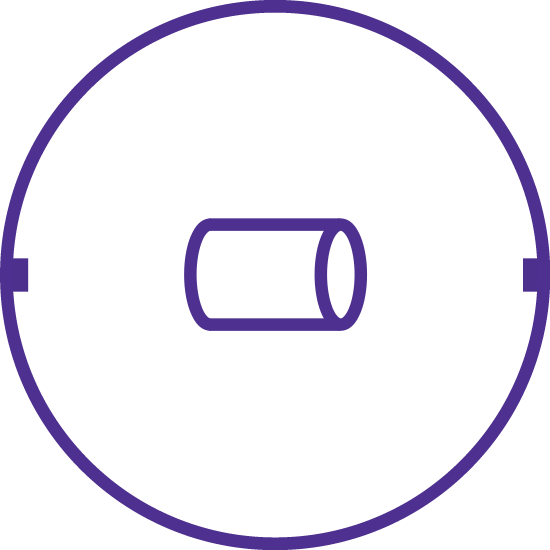
High-Energy Laser
An intense sequence of laser pulses with megajoules of energy converge on the cm-sized fusion fuel capsule in billionths of a second.
-
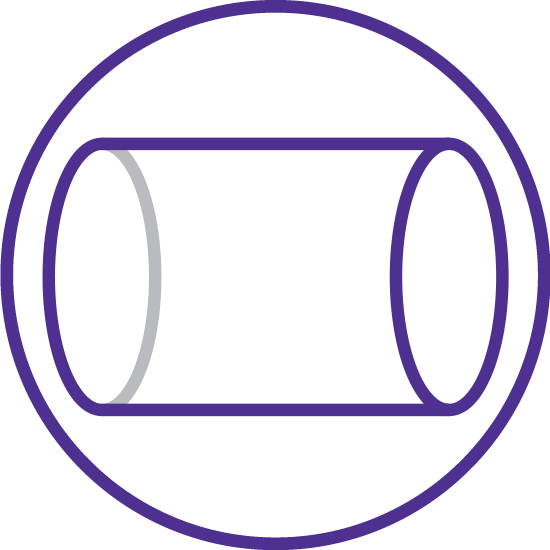
Fuel Capsule
The laser energy generates over 100 million atmospheres of pressure around the fusion fuel capsule, causing it to implode, heat, and ignite.
-
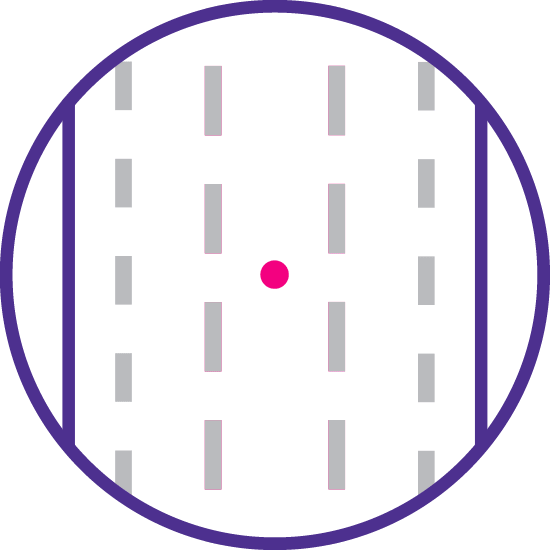
Chamber
Molten salt in the chamber heats as it absorbs the fast burst of fusion energy, and the process is repeated every couple seconds
Lasers create an incredibly intense pulse of light, focused onto a sphere of fuel the size of a pea, creating high temperature and pressure that initiates fusion reactions.
A capsule is ignited every few seconds, only when the laser fires. The generation and release of energy is inherently controlled. The fusion energy from each burning capsule is converted to heat in the chamber walls. A circulating coolant absorbs and carries away the heat to generate steam, which in turn drives turbines to produce electricity. No long-lasting or dangerous radioactive waste is released in the process.
The National Ignition Facility made inertial fusion a reality in 2022.
Governments and universities worldwide have been pursuing fusion energy for 50 years.
On December 5, 2022, the National Ignition Facility (NIF) at Lawrence Livermore National Lab performed an experiment in which a 2.05-megajoule laser pulse yielded 3.15 megajoules of fusion energy output. It was the first time fusion scientific breakeven has been achieved in a laboratory.
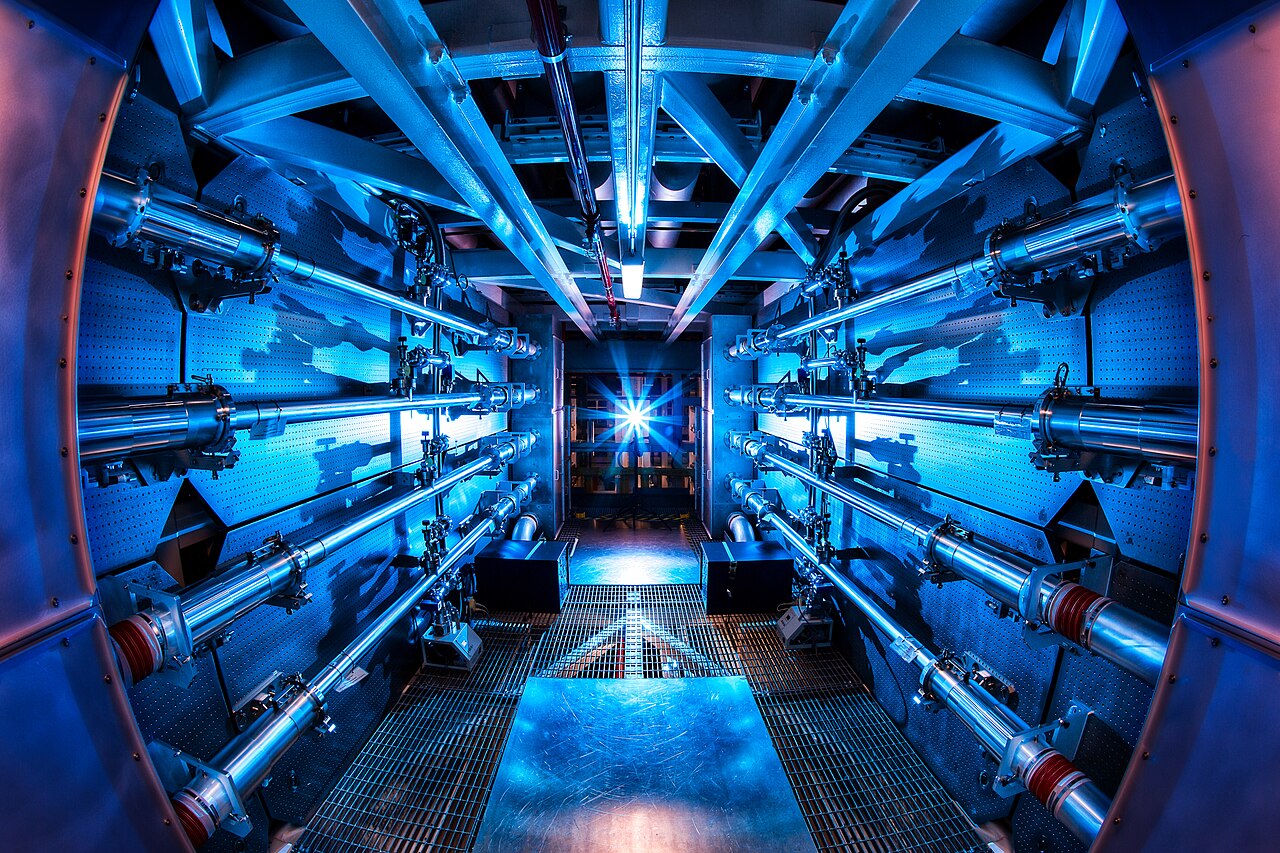
The challenge: scalability & economics.
NIF’s groundbreaking result was very expensive to achieve, took decades of development, and doesn’t produce enough energy gain for commercial operation. Many obstacles remain to scale this result for commercial use, including the cost of the laser.
Each of NIF’s beamlines uses a series of precision glass optical elements to generate, control and precisely direct light towards the target. Because glass can only handle a certain amount of laser energy without being damaged, NIF must spread 2 megajoules of laser energy over 192 independent beamlines, at significant expense.
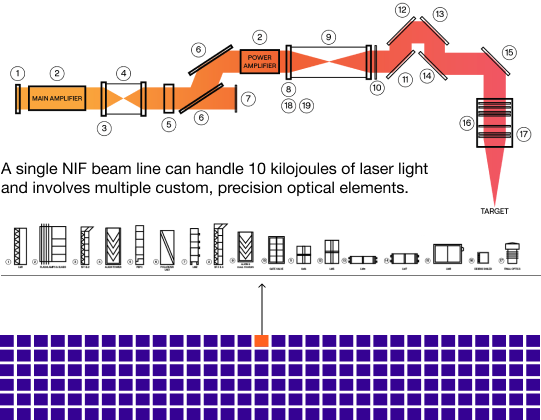
The entire NIF facility requires 192 beam lines and 120 tons of precision glass, with a total system cost of over $3,600,000,000
-
What exactly has the NIF achieved?
The NIF achieved what is known as scientific breakeven, defined as the fusion energy released from a plasma exceeding the energy that was used to create and heat the plasma. The process of inertial fusion involves shooting a fusion “target” in the center of a large vacuum chamber with a high-energy short laser pulse. The laser energy is ultimately used to compress, heat, and ignite fusion fuel in the target, and the accepted definition of scientific breakeven for inertial fusion is when the fusion burst from the target exceeds the energy of the laser pulse that fires into the chamber toward the target.
To date, the NIF is the only facility that has achieved scientific breakeven in the lab, and the current highest performing shot at the NIF produced 5 MJ of fusion energy from a 2 MJ laser pulse, corresponding to a “scientific gain” of 2.5. To date, the next-best performing system is the JET tokamak, which achieved a “scientific gain” of 0.67.
-
Why is the NIF scientific breakeven achievement significant?
To answer this we need to briefly describe a NIF fusion target. A NIF target consists of a heavy metal (such as gold) can about 1 cm in size with a 2 mm diameter spherical fuel capsule situated inside the can. The fuel capsule contains roughly 0.2 milligrams of fusion fuel, as well as a plastic layer on the outside surrounding the fuel. On the NIF, the laser beams do not hit the fuel capsule directly, but instead hit the inside of the can. This creates an intense bath of x-rays that fills the can and heats the plastic layer on the fuel capsule. The plastic layer blows off in billionths of a second creating a compressive force inwards that implodes, heats, and ignites the fusion fuel inside. While the NIF laser delivers 2 MJs of energy to the can, only 250 kJ of energy is actually absorbed by the fuel capsule from the x-rays. The implosion of the capsule can be thought of as a spherical "rocket" with the fusion fuel as the payload, and like a rocket’s efficiency only about 10% of the absorbed energy (~25kJ) ends up in the compressed fuel as heat.
What is significant is that the fuel capsule itself produced 5 MJ of fusion energy when only absorbing 250 kJ of energy. This corresponds to a fuel capsule gain of 20! This gain was possible because a fully ignited and self-sustained burning plasma was produced. This is highly scalable, and up to 10x higher fuel capsule gains can be achieved by imploding a much larger capsule.
-
What is the overall energy gain of the NIF?
Let’s take a look at the overall energy budget of NIF’s highest performing shot to date. 400 MJ were taken from the grid and stored in capacitors to power the laser. The laser produced 2 MJ of optical energy delivered to a NIF “target”, which consists of a fuel capsule about 2 mm in size inside a heavy metal can about 1 cm in size. The laser pulse was delivered to the inside wall of the can, which was heated by the laser to millions of degrees, creating a thermal x-ray bath inside the can. The fuel capsule absorbed roughly 250 kJ of energy from this x-ray bath, causing it to implode, ignite, and burn, releasing 5 MJ of fusion energy. Thus the fuel capsule gain was 20, the target gain (equivalent to the scientific gain) was 2.5, the fuel capsule absorbed 12% of the energy that was in the laser pulse, and the laser efficiency itself was 0.5%. This corresponds to an overall “wall-plug” energy gain of just over 0.01, or 1%.
-
Isn’t the low overall energy gain of the NIF a major challenge to overcome?
A commercial system must have a wall-plug gain of ~10, as opposed to the 1% achieved on the NIF. This might seem like a major gap, but with a much more efficient and energetic laser, it is not as challenging as it might seem. It is important to note that NIF was never designed for efficiency and the laser is based upon technology of the 1990’s. The NIF was built for science to support the national security mission of the National Nuclear Security Administration (NNSA) to help ensure the safety and reliability of the US nuclear deterrent.
In an Xcimer system, we will achieve 10x higher fuel capsule gain by absorbing over 30x more energy into a much larger capsule, we will achieve over 10x higher laser efficiency through the use of excimer lasers, and we’ll couple over 90% of the laser energy directly to the fuel capsule, vs. only 12% coupled via the x-ray bath on the NIF. These together provide a 1000x increase in wall-plug gain compared to the NIF, allowing for a commercially viable system.
-
Why can’t the NIF laser be scaled for Inertial Fusion Energy?
While the NIF has made an amazing achievement, there are several significant challenges in making the laser system commercially viable.
• The laser technology is far too expensive to scale to 10 MJ, which is the energy level needed for robust fusion target operation. The NIF contains over 120 tons of high quality laser glass, as well as over 4000 square meters of optical surfaces to direct the laser beams to a target. This large volume of precision optical material contributed a significant amount to NIF’s $3.5B cost.
• The NIF can only shoot a few times a day, vs a shot every few seconds. Even at 2 MJs of energy, the NIF experiences a significant amount of damage to its optics on every shot - over $40M per year is spent on refurbishment of the optics. Going to 1 shot every few seconds would simply be unaffordable.
• The NIF has 192 beams and 30 square meters of final optical area. This high number of penetrations and large final optical area exposed to the target make it infeasible to use a coolant as a liquid wall to protect the reactor chamber.While there have been significant advancements in solid-state laser technology since the NIF was built, solid-state glass systems are still very expensive, not scalable to 10 MJ, and must still use a large number of laser beams to hit a target.


